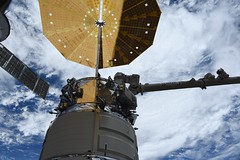Cygnus before departing
mercredi 30 juin 2021 à 09:44Thomas Pesquet posted a photo:
Le Cygnus NG-15 au bout du Canadarm. Grâce au bras robotique, on va le désamarrer puis étendre le bras, et le relâcher à environ 10 mètres de la Station, il va ensuite voler de ses propres ailes (enfin disons avec son propre système de propulsion). Les vaisseaux cargo Cygnus :us: et HTV :jp: sont amarrés et désamarrés de l’ISS manuellement, à l’aide du bras robotique. C’est une façon élégante et sûre d’opérer à proximité d’une station spatiale, mais les véhicules les plus récents, ainsi que ceux du futur (notamment pour la station Gateway autour de la lune) implémentent un arrimage automatique basé sur des capteurs GPS et optiques
The Cygnus NG-15 locked and loaded onto the Canadarm. Tonight we send this beautiful spacecraft on her way... We will close the hatch to Cygnus and detach the spacecraft, extend the arm with the spacecraft on it to 10 m from the International Space Station... and release. Cygnus will spread its wings (figuratively) and depart on its own power. The US commercial Cygnus and Japanese HTV are the last types of cargo spacecraft that arrive and leave with the help of the robotic arm. An elegant and safe way of arriving at a space station but this method is being phased out because you need a robotic arm operator and a robotic arm to catch it, so for the most recent vehicles like SpaceX’s cargo Dragon or for the next station we will be building around the Moon – the Gateway – the spacecraft are being designed to dock on their own using GPS and optical navigation. :sunglasses:
Credits: ESA/NASA–T. Pesquet
439C5242
